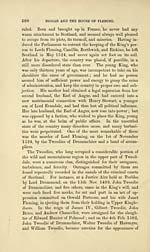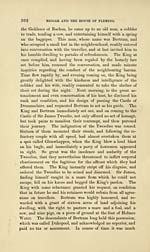Biggar and the House of Fleming
(531) Page 513
Download files
Complete book:
Individual page:
Thumbnail gallery: Grid view | List view

HISTORICAL SKETCHES OF THE FLEMING FAMILY. 501
the said Gilbert Tweedie at the next Justice Aire at Peebles,
under the penalty of 100 merks. On the 26th January
1565-6, "Adam Twedie of Drawey was dilatit of (the crime
of) cutting Robert Raimagis luggis, and demembring him
thairof." The panel did not deny his guilt, but pleaded the
King and Queen's remission, 30th Nov. 1565, and was accord-
ingly absolved. Patrick Veitch, son of William Veitch of
Dawick (now New Posso), was in 1590 slaughtered by or
through James Tweedie of Drummelzier, Adam Tweedie of
Dreva, William Tweedie of the Wrae, John Crichton of Quar-
ter, Andrew Crichton in Cardon, and Thomas Porteous of
Glenkirk. These persons were in prison in Edinburgh for
the fact in July of that year ; but the case was deferred to
the aire of Peebles.
The principal residence of the chief of the clan Tweedie was
situated on the banks of the Tweed at Drummelzier. It was
a building of great size and strength, but its situation was ill
chosen either for assault or defence. To compensate for this
disadvantage, they erected a fort on a neighbouring eminence,
which was called the Thane's Castle, but more commonly, by
the country people, Tennis Castle. It is a tradition that it
was a custom of the Tweedies to demand an act of homage
from every person that passed these strongholds, and to inflict
severe punishment in case of refusal. This imperious conduct
brought them at times into collision with the Scottish kings,
who made them feel the full weight of the royal displeasure.
An instance of this is still related by the peasantry of Tweed-
dale and Clydesdale, and is more or less detailed in several
publications. It is to the following effect ; — One of the
Jameses, having heard of the overbearing and tyrannical con-
duct of the Tweedies, resolved to visit Drummelzier incognito,
and witness, in person, the treatment which they bestowed on
strangers. He went, as was a very common practice with our
Scottish monarchs, to hunt the fallow deer in the wilds of
Tweedsmuir and Ettrick Forest, attended by a considerable
retinue. Having made some of his courtiers privy to his de-
sign, and enjoined them to keep themselves concealed among
the hills, but to remain within hail, he disguised himself, and as
a solitary traveller descended the Vale of Tweed. At a place
not far distant from the Castle of Kittlehall, the ancient seat of
the said Gilbert Tweedie at the next Justice Aire at Peebles,
under the penalty of 100 merks. On the 26th January
1565-6, "Adam Twedie of Drawey was dilatit of (the crime
of) cutting Robert Raimagis luggis, and demembring him
thairof." The panel did not deny his guilt, but pleaded the
King and Queen's remission, 30th Nov. 1565, and was accord-
ingly absolved. Patrick Veitch, son of William Veitch of
Dawick (now New Posso), was in 1590 slaughtered by or
through James Tweedie of Drummelzier, Adam Tweedie of
Dreva, William Tweedie of the Wrae, John Crichton of Quar-
ter, Andrew Crichton in Cardon, and Thomas Porteous of
Glenkirk. These persons were in prison in Edinburgh for
the fact in July of that year ; but the case was deferred to
the aire of Peebles.
The principal residence of the chief of the clan Tweedie was
situated on the banks of the Tweed at Drummelzier. It was
a building of great size and strength, but its situation was ill
chosen either for assault or defence. To compensate for this
disadvantage, they erected a fort on a neighbouring eminence,
which was called the Thane's Castle, but more commonly, by
the country people, Tennis Castle. It is a tradition that it
was a custom of the Tweedies to demand an act of homage
from every person that passed these strongholds, and to inflict
severe punishment in case of refusal. This imperious conduct
brought them at times into collision with the Scottish kings,
who made them feel the full weight of the royal displeasure.
An instance of this is still related by the peasantry of Tweed-
dale and Clydesdale, and is more or less detailed in several
publications. It is to the following effect ; — One of the
Jameses, having heard of the overbearing and tyrannical con-
duct of the Tweedies, resolved to visit Drummelzier incognito,
and witness, in person, the treatment which they bestowed on
strangers. He went, as was a very common practice with our
Scottish monarchs, to hunt the fallow deer in the wilds of
Tweedsmuir and Ettrick Forest, attended by a considerable
retinue. Having made some of his courtiers privy to his de-
sign, and enjoined them to keep themselves concealed among
the hills, but to remain within hail, he disguised himself, and as
a solitary traveller descended the Vale of Tweed. At a place
not far distant from the Castle of Kittlehall, the ancient seat of
Set display mode to:
![]() Universal Viewer |
Universal Viewer | ![]() Mirador |
Large image | Transcription
Mirador |
Large image | Transcription
Images and transcriptions on this page, including medium image downloads, may be used under the Creative Commons Attribution 4.0 International Licence unless otherwise stated. ![]()
| Histories of Scottish families > Biggar and the House of Fleming > (531) Page 513 |
|---|
| Permanent URL | https://digital.nls.uk/94845654 |
|---|
| Description | A selection of almost 400 printed items relating to the history of Scottish families, mostly dating from the 19th and early 20th centuries. Includes memoirs, genealogies and clan histories, with a few produced by emigrant families. The earliest family history goes back to AD 916. |
|---|

